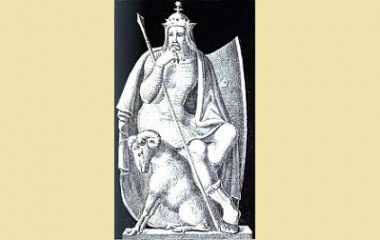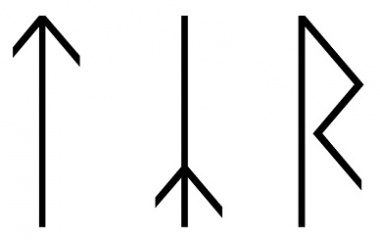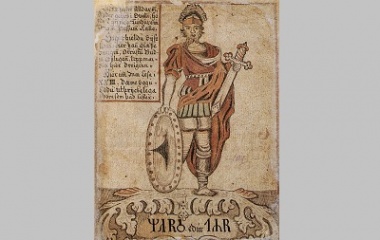- Pronunciation: tee-uhr
- Origin: Germanic
- Role: Warrior, god of justice
- Symbols: Spear, glove
- Parents: Odin, Frigg
Who Is Tyr?
The mighty warrior Tyr was an early god in the legends of the Norse. The remaining myths of Tyr are few, although his legacy stands as symbol of justice and lawfulness. Tyr is considered the bravest and boldest of the gods, and an inspiration for courage and heroism in battle.
Tyr was an original member of the Aesir clan, the principle deities of the Norse pantheon, and the son of Odin. Odin seems to have preempted his following in the latter years as the culture evolved during the time of the Vikings, when the legends started to be written down. However, it is theorized that Tyr may have been the leader of the gods in the earlier period.
Origin
Tyr is an enigmatic figure in mythology as much of his story was lost while the myths were still passed on by word of mouth. We do know from the Prose Edda, a work written by historian Snorri Sturluson in Iceland in the early 13th century, how he lost his right hand.
The Binding of Fenrir Wolf
Fenrir was the gigantic wolf offspring of the deity Loki and the giantess Angrboda. When he was born, it was prophesized that he would one day assist in the destruction of the cosmos. As he grew larger and increasingly fierce, the gods of the Aesir decided that he needed to be contained for their protection.
The gods’ first attempt to bind Fenrir the wolf was unsuccessful. He snapped the chain with one swift kick. They tried again with a fetter twice as strong, but the giant wolf managed to release himself from that bind, too. By this point, the gods were growing increasingly concerned, and Odin, the father of Tyr, sent a message underground to the ornery black elves for assistance.
The dwarves agreed to concoct a shackle made from six magical ingredients: the ligaments of a bear, the beard of a woman, the sound of a cat’s feet, the root of a mountain, the breath of a fish, and the spit of a bird. The result was a chain as smooth as silk but as strong as iron.
Fenrir, who was initially enjoying the chain game as an opportunity to show off his strength, secretly doubted his ability to break free from this particular fetter and demanded a showing of good faith before he would allow it to be put on him.
Tyr stepped up and bravely placed his hand in the mouth of the wolf as an offering of good faith on behalf of all the gods. Only then did Fenrir allow the chain to be placed on him. His attempts to break free this time were unsuccessful. Frustrated and angry at his entrapment, he snapped off Tyr’s hand. Tyr had sacrificed his hand for the safety of the gods.
The rest of the Aesir jumped in and looped the chain through a giant slab of stone which was anchored with a large rock and Fenrir was left bound permanently to that spot. The howling wolf was later muzzled. He would remain silent until the time of Ragnarök, the doom of the gods.
Family of Tyr
The father of Tyr is Odin, know commonly as the All father, and chief of the Aesir clan. He is a complex and infamous figure of Norse mythology, and was known to often stray from the Asgard kingdom of the gods on journeys to other parts of the cosmos. Odin embodied dichotomous qualities. He was a seeker of wisdom, but showed little regard for fairness or justice. He was a courageous warrior who also displayed feminine characteristics.
The wife of Odin, and mother of Tyr, is Frigg. She is a Norse representation of love and marriage and a goddess of the sky. Also known as a seer, she knew what would happen in the future but could not alter it.
The Battle of Tyr and Garm
When the time came for the end of the cosmos, the battle of Ragnarok began the destruction of the Nine Worlds. The war of good and evil ensued, and Odin led the gods into battle against Loki and the giants and monsters.
Despite, knowing their fates, the gods defiantly faced their destiny, and each of them was matched in battle with a giant or a monster. The one-armed Tyr was destined to battle with the helldog of the underworld, Garm. In the end, Tyr managed to slay Garm but suffered wounds so great he also succumbed to death.
One of the major events that heralded Ragnarok was the escape of Fenrir the wolf from his magical bind. Some mythologists believe that Garm and Fenrir are the same figure, as it seems most plausible that Tyr would be destined to fight Fenrir in the final battle. He had tricked Fenrir and lost his arm in the process. If they are not the same figure, then they are certainly similar figures, and both represent the forces of chaos breaking fee at the time of the destruction of the world.
Influence
Tyr was later associated by the Romans with the planet Mars, and they named a day of the week in his honor, Tuesday (Týsdagr). There is also a municipality in Norway named for Tyr, and called Tysnes.
Later, he became less important than his infamous father, Odin. By the years 21 to 700 AD, the migration period of the Germanic people to and within Europe, much of the ancient legend of Tyr had been lost. Marvel Comics introduced Tyr to popular culture by featuring a character based on the Norse god – a sword-carrying Asgardian warrior with superhuman powers.










